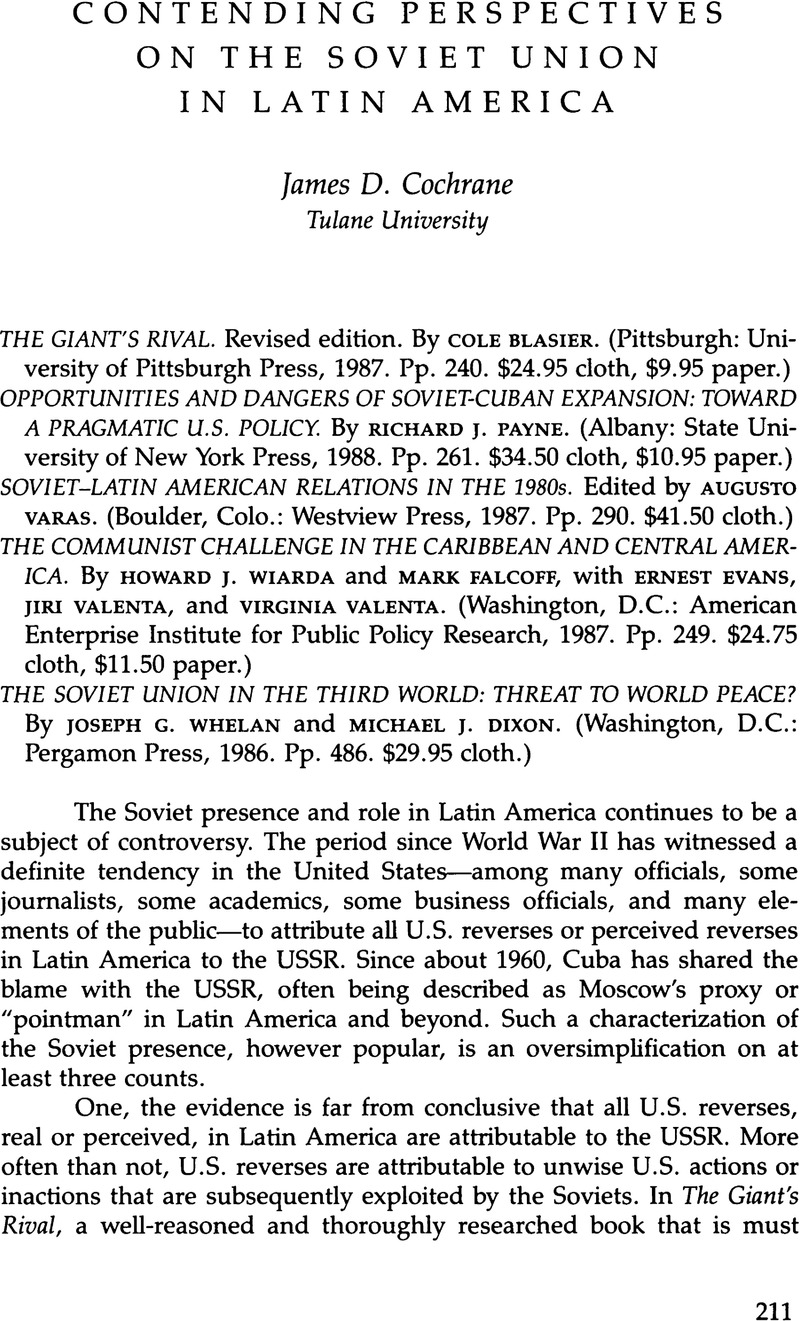Article contents
Contending Perspectives on the Soviet Union in Latin America
Review products
Published online by Cambridge University Press: 12 October 2022
Abstract

- Type
- Review Essays
- Information
- Copyright
- Copyright © 1989 by the University of Texas Press
References
Notes
1. In this context, I am not including Cuba when I speak of Latin America as a whole. The reason is that the Soviet-Cuban relationship differs fundamentally from Soviet relationships with all other countries in Latin America.
2. G. Pope Atkins, Latin America in the International System (New York: Free Press, 1977), 79.
3. Joseph L. Nogee and Robert H. Donaldson, Soviet Foreign Policy since World War II (New York: Pergamon, 1981), 174.
4. See Raymond L. Garthoff, Reflections on the Cuban Missile Crisis (Washington, D.C.: Brookings Institution, 1987); and Lars Schoultz, National Security and United States Policy toward Latin America (Princeton: Princeton University Press, 1987), especially chap. 7.
5. Robert A. Pastor, “Cuba and the Soviet Union: Does Cuba Act Alone?” in The New Cuban Presence in the Caribbean, edited by Barry B. Levine (Boulder, Colo.: Westview, 1983), 203.
6. On the hegemonic system, see James R. Kurth, “The United States, Latin America, and the World: The Changing International Context of U.S.–Latin American Relations,” in The United States and Latin America in the 1980s: Contending Perspectives on a Decade of Crisis, edited by Kevin J. Middlebrook and Carlos Rico (Pittsburgh., Pa.: University of Pittsburgh Press, 1986), 61–86.
7. Robert Wesson, “Conclusion,” in U.S. Influence in Latin America in the 1980s, edited by Robert Wesson (New York: Praeger, 1982), 223.
8. Other examples of this perspective, although not precisely in line with Payne's, are James Chase, Endless Wars: How We Got Involved in Central America—and What Can Be Done (New York: Vintage, 1984); Cynthia Brown, With Friends Like These: The Americas Watch Report on Human Rights and U.S. Policy in Latin America (New York: Pantheon, 1985); Walter LaFeber, Inevitable Revolutions: The United States in Central America (New York: Norton, 1983); and H. Michael Erisman, “Colossus Challenged: U.S. Caribbean Policy in the 1980s,” in Colossus Challenged: The Struggle for Caribbean Influence, edited by H. Michael Erisman and John D. Martz (Boulder, Colo.: Westview, 1982), 1–46.
9. For other examples of this perspective, see The Report of the President's National Bipartisan Commission on Central America (New York: Macmillan, 1984); Jiri Valenta, “Soviet Policy and the Crisis in the Caribbean,” in Erisman and Martz, Colossus Challenged, 47–82; and Edward N. Luttwak, “The Nature of the Crisis,” in Central America and the Western Hemisphere, edited by Joseph Cirincione (New York: Holmes and Meier, 1985), 71–79.
10. Voytek Zubek, “Soviet ‘New Thinking’ and the Central American Crisis,” Journal of Inter-American Studies and World Affairs 29, no. 3 (Fall 1987):88.
11. Howard J. Wiarda, “The Central American Crisis: A Framework for Understanding,” AEI Foreign Policy and Defense Review 4, no. 2 (1982):6.
12. Wesson, “Conclusion,” U.S. Influence in Latin America in the 1980s, 225.
13. Leon Goure, “Latin America,” in The Soviet Impact on World Politics, edited by Kurt L. London (New York: Hawthorn, 1974), 195.
- 2
- Cited by




